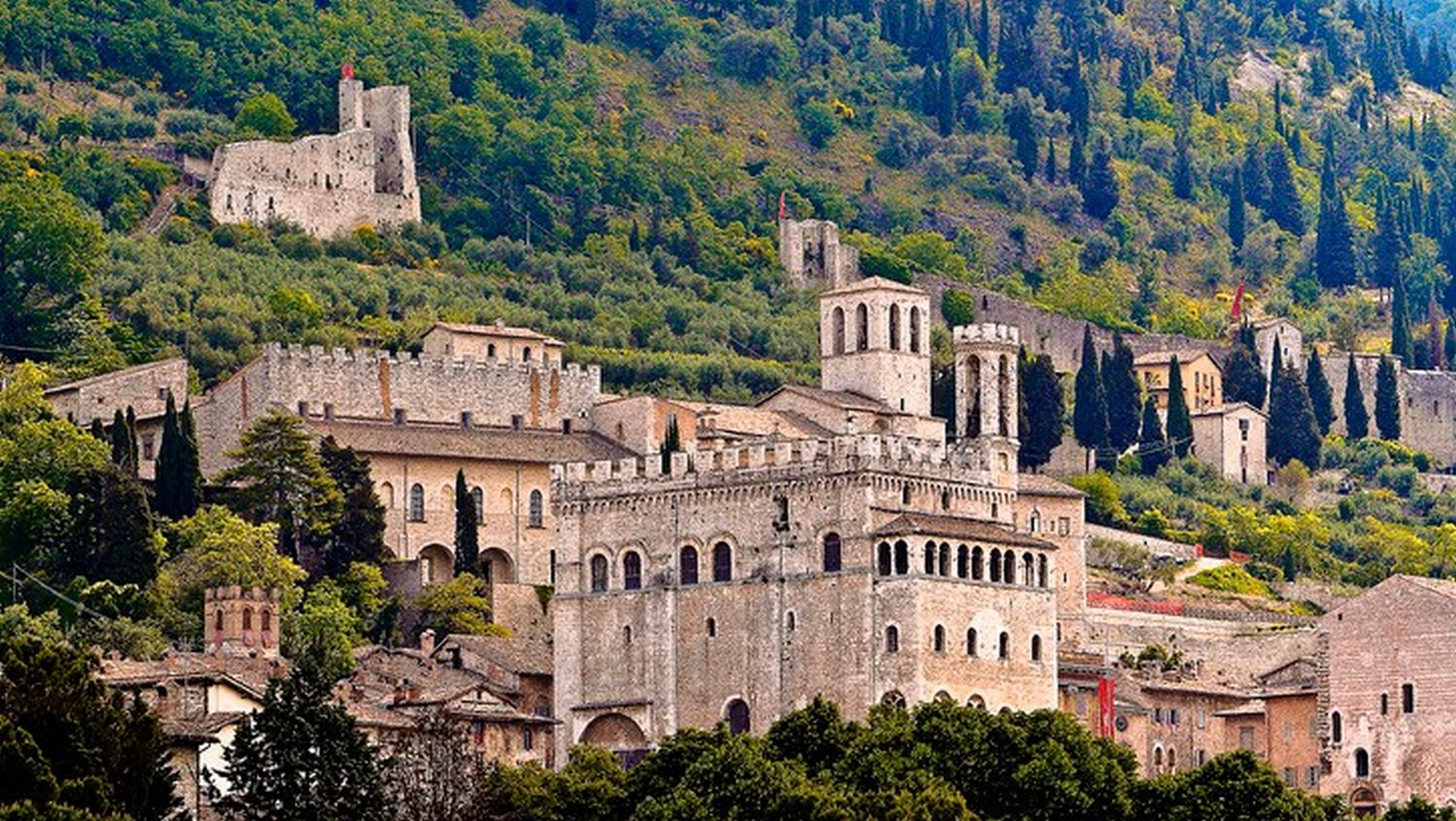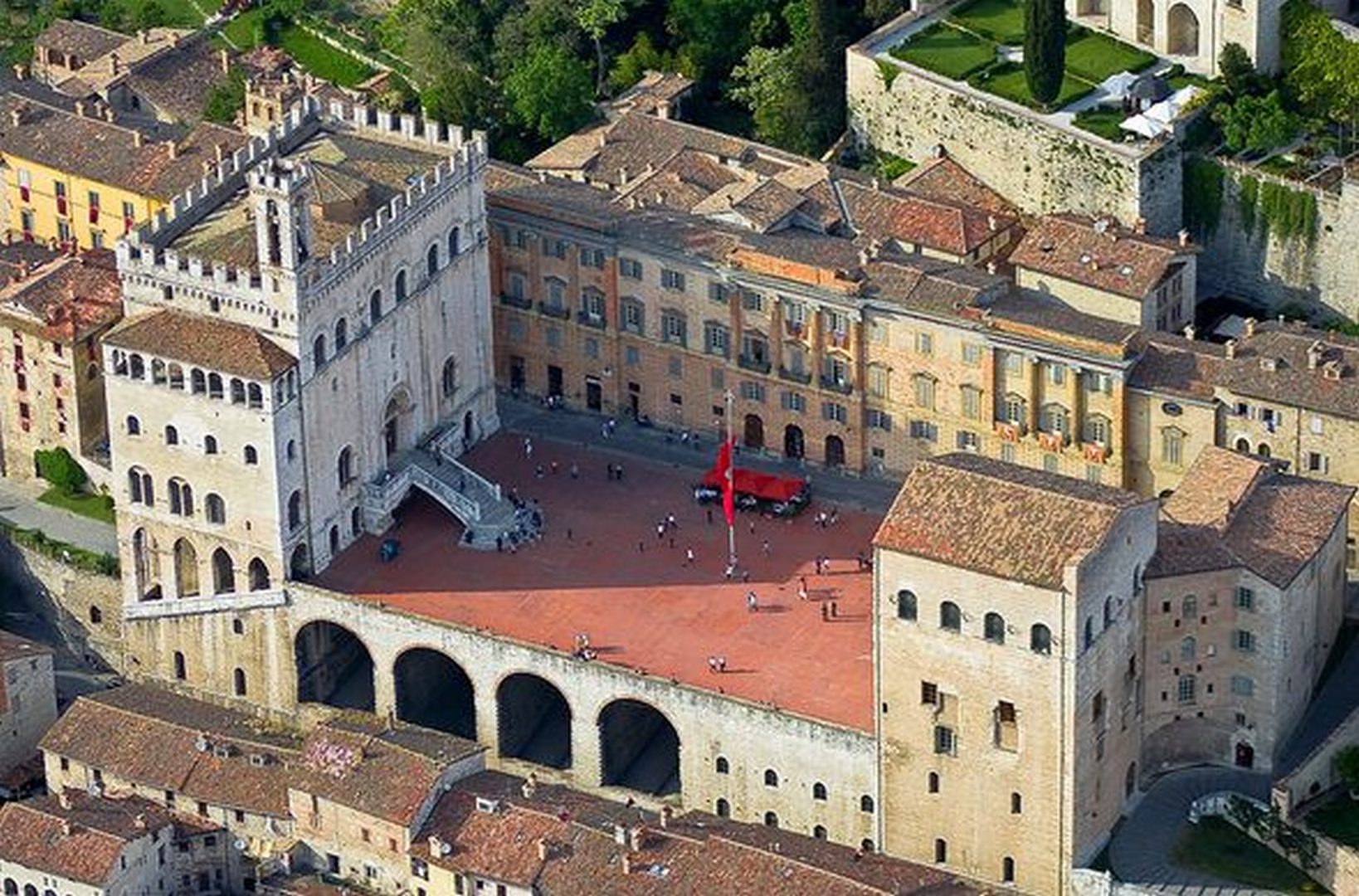In the heart of Umbria, nestled between rolling hills and overlooked by Monte Ingino, lies Gubbio. Often called the “grey city", not because of the smoke or the shy temper of its inhabitants, but because of the even color of the limestone blocks with which it is built. This material gives Gubbio a unique appearance, which seems to pause this city suspended in stone.
But this is not the only nickname the city has earned: it is known as the “City of Fools", and it can also boast the world's largest tree. In short, Gubbio offers a unique combination of history, bizarre curiosities, art and nature, making it an ideal destination for an unforgettable holiday. Come with us to discover it!
Gubbio: some historical background
Gubbio is one of the oldest towns in Umbria, with a history rooted in Umbrian and Roman times. Already inhabited by the Umbrians in the 3rd century B.C., it was known as Ikuvium, a city-state of great influence testified by the Eugubine Tables, one of the most important Italic archaeological findings. In Roman times, it then became a strategic center due to its position along the main communication routes. Its status, however, is a consequence of what happened during the Middle Ages, when Gubbio reached its utmost glory, as shown by the historic buildings located in the city center and the towering walls. Well-known all-over Italy for the 'Festa dei Ceri', a traditional event rooted in the 12th century, and for the legendary episode of St. Francis taming the wolf, Gubbio is a city where history is constantly intertwined with myth.
How to reach Gubbio
As previously mentioned, Gubbio is located strategically, and in fact can be easily reached by car or public transport. From Perugia, you can take the SS298 road for about 40 kilometers. Otherwise, from Ancona or Rome, you can take the SS3 Flaminia. For those who prefer public transport, the nearest railway stations are Fossato di Vico and Perugia, both connected to Gubbio through local buses.
Gubbio's must-see
Gubbio is a city full of hidden treasures to discover, including a unique world record: the world's largest Christmas Tree ever made. Since 1981, a group of volunteers has been contributing to create this light installation on the slopes of Mount Ingino, which lies behind the town. Measuring 450 meters at its base and over 750 meters high, the tree illuminates the 'eugubinian' (that is how Gubbio's inhabitants and everything that revolves around Gubbio is called) sky and ideally links the medieval walls with the Basilica of Sant'Ubaldo on the top of the mountain. Let's get to know together the other gems that this incredible city has to offer!

Piazza Grande
Let's start from the very heart of the city: Piazza Grande. A masterpiece of medieval engineering, this “suspended" square is built upon a structure of large arches, clearly visible from the bottom of Gubbio's city center, and boasts a breathtaking view of the valley below and the surrounding historical buildings. This is where one can breathe in the city life, while enjoying and admiring medieval Gubbio in all its splendor.

Palazzo dei Consoli
The town emblem, Consoli Palace dominates Piazza Grande with its grandeur and is also well-known for a specific historical record: it was the first Italian palace to have running water, plumbing and toilets, a sign of the city's status and power. Built in the 14th century, it now hosts the Civic Museum, where it is possible to admire the aforementioned Eugubine Tables, valuable evidence of Umbrian language and civilization. To visit this palace means plunging into history, all enhanced by an astonishing view from the terrace.
Cathedral of Gubbio
The Dome, or Cathedral of Saints Marian and James, is a prime example of Umbrian Gothic architecture and is located on the opposite side of Palazzo Ducale. Built in the 12th century, this building distinguished itself from others thanks to its arcades framing the single nave and the large stained-glass window in the apsis. In front of the altar, an amazingly decorated ceiling catches the eye, reminiscent of a starry sky, and the tourist is totally immerged and surrounded by wonderful frescoes.
Saint Francis' Churches
There are two churches dedicated to Saint Francis in Gubbio: Church of San Francesco della Pace and the Church of San Francesco, built in the 13th century on the exact site where the saint found shelter. The former is a hidden gem in the center of Gubbio, built above the cave in which the she-wolf tamed by Saint Francis lived, while the latter stands out for its Gothic architecture and frescoes narrating the life of the saint. Both are worth a visit, in order to better understand and get to feel the deep connection between Gubbio and its spiritual patron.
Bargello Fountain
The Bargello Fountain, located in the heart of the town centre, is a symbolic spot in Gubbio, especially for superstitious people. According to the tradition, whoever manages to complete three laps around the fountain symbolically earns the so-called “madman's licence", linked to the previously mentioned sense of humor and irony that characterizes the inhabitants of Gubbio.
Roman Theatre
Dating back to the 1st century BC, the Roman Theatre in Gubbio is one of the most impressive testimonies of Roman times in Umbria. Immaculately preserved, it still hosts performances and historical re-enactments, bringing the atmosphere of antiquity back to life.

Ranghiasci Park
Just a few steps from the town center, such a romantic park is a total oasis of peace. With shady paths, panoramic views and picturesque corners, it is the ideal place for a reinvigorating stroll surrounded by nature.
Basilica of Sant'Ubaldo
Perched on the summit of Monte Ingino, this basilica is a site of great peace and beauty. It holds the remains of Saint Ubaldo, the patron saint of the town. Also reachable by cable car, the basilica offers a sweeping view of Gubbio and the surrounding hills.
A day's sightseeing in Gubbio: the itinerary
The town, although packed with things to see, can be visited easily in one day. You can start with a visit to the Church of San Francesco, which is close to several parking lots though not quite central. Then continue to the characteristic 'Logge dei Tiratori', a building with an arcade and bordered by the church of Santa Maria dei Laici, which was once a hospital. Next, you may take a stroll around Piazza Grande and a visit to the Consoli Palace and continue on to the Roman Theatre and the nearby Ranghiasci Park for a moment of relaxation. After a lunch in a typical trattoria, you can catch the cable car to the Basilica of Sant'Ubaldo and admire the stunning view. Finally, you can conclude the day by strolling through the streets of the center, past artisan workshops and characteristic bars.
Enjoy Gubbio with your children
Umbria is a perfect family-friendly destination, and Gubbio makes no exception. The little ones will love the Roman Theatre, the suspended square, and the open-air cable car to the Basilica of Sant'Ubaldo, a truly fun and adventurous experience. In addition to the inevitable visit to the Bargello Fountain, you can also go for a free visit to the “biggest barrel in Europe" or rather the “big barrel of the canons", located in one of the cellars under Consoli Palace. If tiredness sets in, you can also opt for the Gubbio Express, which will take you on a comfortable tour to visit some of the city's most picturesque places.
Exploring Gubbio's surroundings
If you have the chance to stay for several days, you can explore Gubbio's surroundings, which offer unmissable attractions.
For instance, Monte Cucco Park is a haven for nature lovers, with hiking trails and caves to explore, while the Bottaccione Gorge, with its geological findings, is an absolute must-see. Furthermore, cities such as Perugia, Assisi and Spello are within easy reach and definitely worth a visit. The surroundings of Gubbio are also rich in small villages, monasteries and abbeys, such as the majestic Camaldolese Abbey of San Salvatore, also known as the Abbey of Montecorona, just a stone's throw from Gubbio, and the beautiful Umbertide. This extraordinary place of worship, dating back to the 11th century and founded by Saint Romuald, which embodies one of Umbria's most fascinating spiritual and architectural treasures
Where to stay to discover Gubbio and its surroundings
Nowadays, the Badia hosts a refined accommodation facility, and is an ideal place to stay and immerse yourself in the tranquility of the Umbrian countryside. The Tenuta di Montecorona is the ideal starting point to explore Gubbio and its surroundings and, at the same time, relax in an exclusive and unique environment, surrounded by the breathtaking beauty of nature. During your stay, you can enjoy some unforgettable experiences: a stroll through the estate's olive groves and orchards, known worldwide for the excellence of the local olive oil and peaches, explore the ancient Hermitage of Montecorona, which rises majestically to dominate the valley with its timeless charm, and be won over by Còlpetrone's wines in an exceptional wine tasting.
Indeed, Gubbio is a place that remains in people's hearts: an intertwining of history, curiosities, nature and traditions that captivate anyone who visits. And for an even more memorable experience, opt for the Tenuta di Montecorona as your retreat and starting point to discover the other wonders Umbria has to offer.
